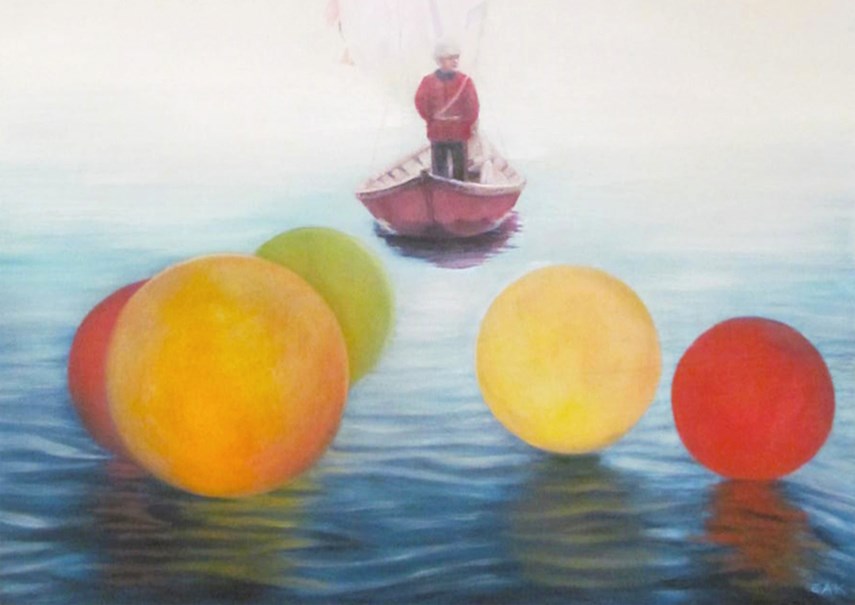Such Stuff As Dreams: Paintings by E. Andrea Klann, Ferry Building Gallery, until Nov. 4. Meet the Artist: Saturday, October 27, 2–3 p.m.
On the surface it was nothing, a seemingly innocuous 8x10 black and white photograph featuring a family of five.
But within that photograph – badly tattered, faded and worn, nearly identical to countless other family portraits from time’s since past – was multitudes for artist Andrea Klann, an opportunity for her to demonstrate her reverence for worlds both imagined and real.
“That was a huge challenge,” she tells the North Shore News. “I did that (piece) within five weeks, it was a Christmas gift for the husband.”
While the photograph and the portrait that Klann eventually painted from it, containing mother and father, two daughters, son and dog, was rooted in the real world and a naturalistic style, parts of it had to be completely conjured up from the artist’s mind.
“You generally need a photograph of something to paint it, otherwise it doesn’t look real. It looks too imagined,” says Klann. “I had to invent all the skin tones, all the hair colours, the clothing colours …”
You might not notice this invented aspect in Klann’s otherwise statesmen-like portrait of the five-person family, but it’s there. It represents her penchant for combining real world minutia with the echoes of her own subconscious, she explains.
“I really admire surrealism, but I also admire magic realism and I like realism,” she says. “I’ve kind of drawn them all together to create this.”
An exhibition featuring more than a dozen of Klann’s paintings is on display at the Ferry Building Gallery in West Vancouver until Nov. 4. Visitors can expect to see even dreamier, more surreal offerings by the Bowen Island-based artist on display during the exhibition’s run, which is candidly titled Such Stuff as Dreams, a line borrowed from Shakespeare’s The Tempest and uttered by the sorcerer Prospero who engaged in art and theatrical illusion.
While Klann highlights the indirect influence of painting masters such as Odilon Redon, Leonora Carrington and Antonio Mancini (“An amazing portrait artist.”), she credits her former North Vancouver art teacher at Hamilton Junior High School, Julia Vernon, for pushing her towards the painter’s life.
“She was brilliant, she was a fantastic teacher, originally from London, and she was always encouraging me,” says Klann.
Since her humble beginnings on the North Shore, Klann has had the opportunity to live and work abroad in both London and Melbourne. She settled on Bowen Island 12 years ago after using a barge to sail an old bungalow style character home from Port Moody to the small island community.
And wherever she’s been in the world, she’s painted.
“It’s really been self-teaching my whole life, it’s a commitment,” she says. “When you want to get into it seriously you just have to teach yourself.”
A perfect example of Klann’s commitment to craft and her hodgepodge of real and imagined artworks is her marionette series. Across four paintings, titled saltimbanque, il voto (the vow), la vero and la cucitrice (the seamstress), she has taken real-world objects and infused them with characters rich in literary and symbolic meaning.
“I was in Italy a while back … and I looked up at the balcony at the owner’s place and there was this three-and-a-half-foot wooden marionette just dangling up there,” says Klann, adding that when she pressed for answers she discovered the owner had in his possession 100 more wooden marionettes, all 150 years old, stored in his attic.
“It was amazing and it was so eerie because they were all together and they were all in a different state of decomposition because they were so old. And yet they had their original clothing even though it was ripped and torn.”
Klann took photographs of the marionettes, captivated by their shape, their age, their possibility for igniting the imagination, and then used them as a launching pad to paint large canvases featuring the figurines’ bodies, as she saw them, while inventing the characteristics in the wooden faces, heads and hands.
“They’re not meant to be disturbing but some people read all sorts of things into them,” she adds.
A captivating dichotomy is taking place in many of Klann’s pieces. Often drawing inspiration from numerous period interiors and designs, she might punctuate what would usually be a realistic looking portrait with another layer that navigates the surreal, the subconscious and, at times, the frightening.
In Girl in Mask, on display at the Ferry Building and described by Klann as “one of my favourites,” a young girl poses in a traditional setting while adorning a jester’s hat and subtle mask.
“I like the sense of mystery and I like the interplay with the jester’s hat that she’s wearing, plus the mask. And the mask doesn’t really allow you to see who she is, to be able to read her, but at the same time because you can see her eyes you can have a connection.”
It’s that connection that Klann says she hopes visitors can experience with her artwork, preferring instead not to talk too widely about what her paintings mean – it’s about what it means to the individual, she notes.
“I much prefer a viewer to actually determine what they think it’s about,” she says. “I would hope that it might fire their imagination, get them thinking and wondering.”



